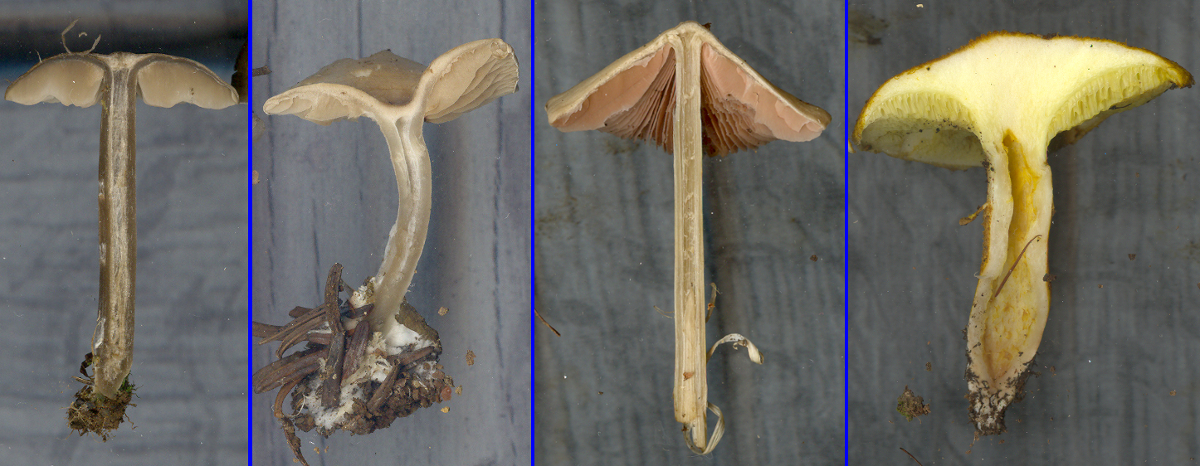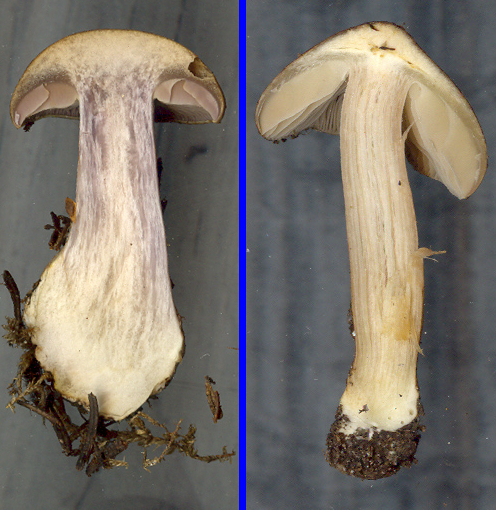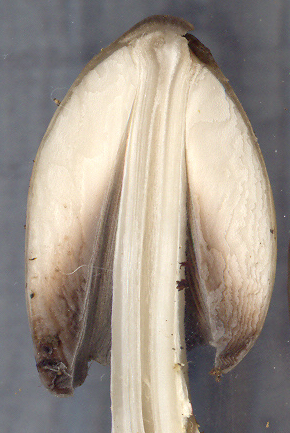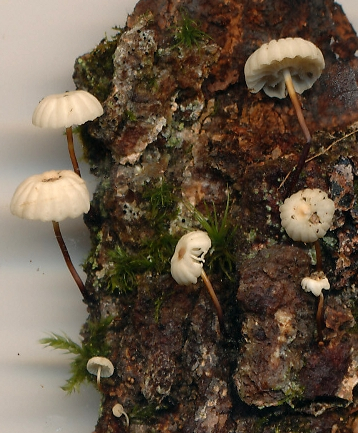STIPE CONTEXT

The main function of a mushroom's stipe is to elevate the pileus a useful distance above the substrate. In many instances this probably raises the pileus high enough to escape some of the dead air in the "boundry layer" and puts it into an area where the air is moving. The differences we observe in mushroom stipes probably reflects the variety of physical stresses endured by the pileus. For example, a small mushroom growing in a wet forest might be vulnerable to large drops of water falling from the forest canopy and must have a stipe capable of withstanding the shock of such hits. In contrast, a large mushroom growing in an open field may hardly be affected by raindrops but may have to bear the weight of a heavy pileus. The length and width of a stipe may reflect some of these stresses, but its interior structure or context is perhaps the best clue to its response to physical stresses as well as being a very useful means of differentiating species.
The photo at left of Cortinarius evernius shows a fairly typical medium-sized mushroom cut in half lengthwise. The context of the pileus seems to be mainly of a dense dark brown tissue with two whitish areas just above the stipe. The stipe itself is clearly made up of two distinct tissues, neither of which resemble the context of the pileus. The outer tissues of the stipe are composed of fairly compactly arranged and vertically oriented hyphae that confer rigidity and strength, while the interior is composed of more loosely arranged but still vertically oriented hyphae. The colours of the two areas may be of contrasting colours as in Cortinarius evernius or they may be rather uniform in colour. Most mushrooms have stipes with this basic plan, but the details and relative importance of the two tissues vary greatly. When writing the descriptive notes for a mushroom we should try to comment at least briefly on how the stipe context appears.

Many mushrooms have a stipe that appears to be hollow or nearly so. In the first three pictures at right (left to right, Entoloma sericeum, Rhodocybe hirneola and Entoloma strictius) the inner tissues are nearly absent or represented by a few hyphae while the outer layer has become thicker and more dense. All of these mushrooms have strong and rigid, but very brittle stipes. The photo at right is of Suillus cavipes, a bolete with a different sort of hollow stipe. Here there seems to be less development of the outer tissues, although they still seem a little different from those of the pileus. Incidentally, the species epithet "cavipes" means "hollow foot" and refers to the consistently hollow stipe of this bolete, a less common characteristic of larger mushrooms. In the field we usually just pinch the stipe to see if it can be compressed, and if it can we know we have S. cavipes.

The two mushrooms at left have stipes that are solid, without any trace of hollowness at all. Cortinarius scaurus, far left, has some differentiation between the two tissues of the stipe, but these are really identifiable because the colour is different. The species of Inocybe at near left seems to have a solid stipe of entirely uniform texture, although very careful examination, with or without a microscope, might reveal some differentiation of tissues. Such uniformity of texture is the most common situation in larger mushrooms.

Coprinopsis atramentaria, in the photo at right, has a rather more complex stipe many other mushrooms. An outer and an inner large of tissues is clearly visible, but the centre of the stipe is entirely hollow. This is an exceedingly strong kind of stipe that allows clusters of these mushrooms to push their way through dense earth or even asphalt. Another feature visible in the photograph is the separation between the tissues of the pileus and the stipe. This sort of "ball-and-socket" attachment of the stipe is characteristic of most species of Agaricus, Amanita, Macrolepiota, as well as some others. Mushrooms with this kind of stipe have the gills attached to the pileus rather than the stipe and are descibed as having free lamellae.

Some very small mushrooms, such as Marasmius rotula, pictured at left, have very thin wiry stipes that are not easily broken. They are hollow and made up of rather thick-walled hyphae. Although fairly tough, they can be broken by pulling on them from both ends. When they do come apart they do so with a distinct snapping sound. Stipes like this are sometimes referred to as cartilaginous, although they are not exactly like cartilage.